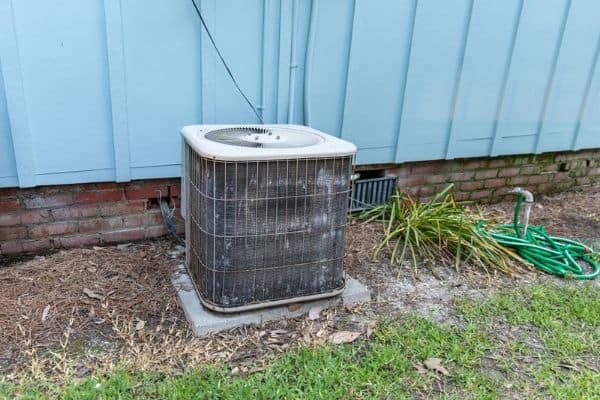What is CFM in HVAC?
To first understand how to calculate for an HVAC system, let’s first introduce what CFM is.
CFM stands for cubic feet per minute (ft^3/min) and is a measure of volumetric airflow or flow rate.
In simple terms: it is the volume of air flowing through ductwork in your HVAC system.
CFM is a measurement of this volumetric airflow (or just airflow for short), not to be confused with air velocity, which is a measure of airspeed. (Air velocity is measured in feet per minute or FPM.)
Air velocity and airflow are related to one another, but they are different measurements.
However, if you know the CFM or FPM of air and the cross-sectional area of the ductwork the air is flowing through, you can use simple math to determine the other one.
For example, if you know the airflow from a 1.5ft x 1.5ft rectangular duct into a room is 400 CFM, you can determine the air velocity by dividing 400CFM by the cross-sectional area of the duct (2.25 sq ft), which yields 177.78 FPM air velocity.
On the flip side, if you measure 200 FPM coming out of a 2 ft diameter round duct, you can determine the CFM by multiplying 200 FPM by the cross-sectional area of the duct (in this case, 3.14 sq ft). This yields 628 CFM airflow.
How to Determine CFM for Homes
All HVAC systems, including air conditioners and furnaces, provide ventilation to every individual room in the home. All of these rooms require proper airflow (or CFM) to make the space comfortable and safe.
The CFM measurements for each room are added together, and the total is used to size an HVAC system for the home properly. It is an essential calculation, though, because undersizing an HVAC system could lead to inadequate heating and cooling, while oversizing often lead to short cycling which could damage the unit.
Both of these cases waste energy and do not condition the home properly. It is also important to get this right for the sake of ductwork sizing.
The airflow in CFM can be determined in two ways – by using the system output or using the airflow requirements of each room. In either case, air changes per hour (ACH) and the volume of each room are essential in the load calculation.
HVAC System Output Calculation
An HVAC system’s total airflow capacity is represented as CFM per square footage. This number is used to determine the correct size of the air handler for the building.
To calculate it, the size of the AC unit (in tons) is needed. Then, multiply the tonnage size by the average output of the system, which is 400, then divide by the home’s square footage.
For example, a 5 ton (60,000 BTU) heat pump in a 1,500 square foot building would have an airflow rate of about 1.33 CFM per square foot (5 tons x 400/1,500sqft). Therefore, if you have a 300 square foot room in the home, it would get airflow at a rate of about 400 CFM (1.33 CFM x 300sqft).
Airflow Room Requirements Calculation
There are different guidelines for the ACH of the various rooms in a house. For example, a kitchen needs to have an air change every 3 minutes (20 ACH) because of the cooking appliances. On the other hand, a family room only requires an air change every 10 minutes or a 6 ACH.
In this CFM calculation example, the ACH of each room is used to determine the proper CFM. However, you will need to know the volume of each room, too– be ready to pull out your blueprint or tape measure to get some dimensions.
Once you’ve determined the length, width, and ceiling height, all you have to do is multiply all three together to get the volume.
For instance, if your family room measures 15 by 20 feet with an 8-foot ceiling, the volume is 15 x 20 x 8, which equals 2,400 cubic feet. Since family rooms, living rooms, and similar areas need an air change every 10 minutes.
To determine the CFM needed, divide the volume by the ACH. In this case, it yields 240 CFM (2,400/10).
This same calculation can be done for every room of the home to calculate the CFM requirement of the HVAC unit and properly size a blower for the air conditioning and heating system.
Charts and Calculator Apps
HVAC professionals commonly use reference charts (cheat sheets) and automatic CFM calculator programs to calculate CFM for homes.
These programs and charts also include the recommended ACH and duct size for each room and are easy ways to ensure the proper CFM is determined for the home.
How is CFM Measured?
The CFM in homes are measured in multiple ways. The two most common methods an HVAC technician will use are pressure-based or hot-wire-based measurements on the supply air. Both are highly accurate methods and can be used at the supply register in a room or anywhere along an HVAC duct.
The CFM is measured by HVAC technicians to ensure that each room is getting enough airflow.
If any room is getting too little or too much airflow, they will balance the system by adjusting dampers in the ductwork. Dampers limit the air flow velocity from the air conditioning system by blocking out a portion of the duct.
Pressure-based CFM Measurement
HVAC technicians can use handheld manometers, which are used with a pitot tube to measure the total pressure and static pressure of the air coming out of the ductwork.
A pitot tube is actually a tube within a tube. One tube has pickups that are perpendicular to the airflow and measure the static pressure (akin to atmospheric pressure) inside the duct.

The other tube of the pitot tube points directly against the airflow. It monitors the “total pressure,” which includes both the static pressure and the pressure of the flowing air, also known as the “velocity pressure.”
The two ports on the pitot tube (total and static pressure) connect to a manometer with flexible PVC tubing. The manometer measures the pressure differential between the two connections. In other words, it subtracts the static pressure measurement from the total pressure measurement, which yields the velocity pressure.
This velocity pressure is a significantly low pressure, measured in inches of water column (in w.c.). This measurement can be plugged in Bernoulli’s Equation, a proven mathematical principle, to calculate the air velocity in FPM. Then, you can multiply the velocity in FPM by the duct’s cross-sectional area to calculate the airflow in CFM.
There are digital manometers available that can automatically do this calculation for you as you are performing the measurements (as long as you input the duct dimensions into the manometer first).
Hot-wire CFM Measurement
Another more straightforward type of CFM measurement involves using a device called a hot-wire anemometer. A hot-wire anemometer is typically a handheld, digital device with a probe that you stick into the ductwork and displays the air velocity (FPM) and airflow (CFM).
The hot-wire works by using a heated filament that is exposed to the airflow. As the air cools the filament, the decrease in temperature is proportionally correlated to the air velocity. The anemometer also has a reference temperature sensor built in to correct for air temperature. Many hot-wire anemometers allow you to input the duct dimensions so you can measure FPM and CFM.









